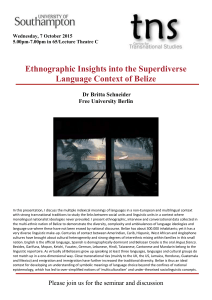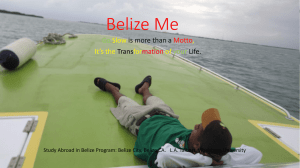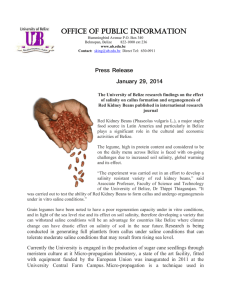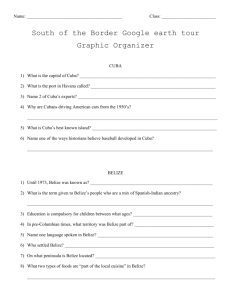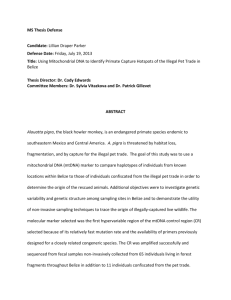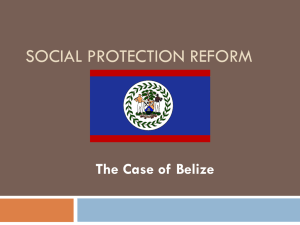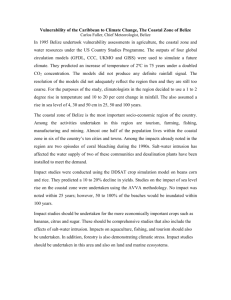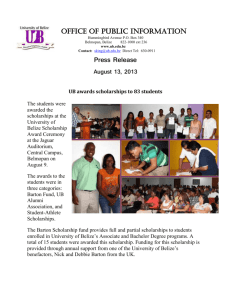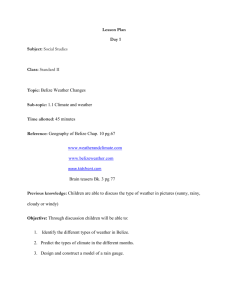1. adaptation strategy and action plan
advertisement
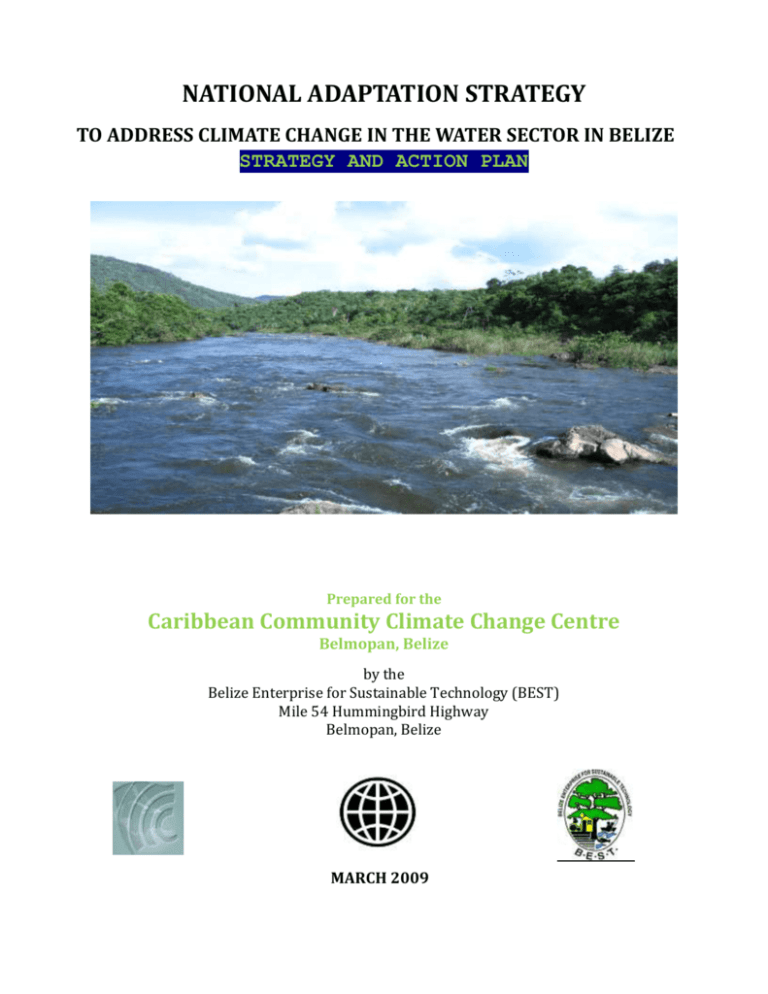
NATIONAL ADAPTATION STRATEGY TO ADDRESS CLIMATE CHANGE IN THE WATER SECTOR IN BELIZE STRATEGY AND ACTION PLAN Prepared for the Caribbean Community Climate Change Centre Belmopan, Belize by the Belize Enterprise for Sustainable Technology (BEST) Mile 54 Hummingbird Highway Belmopan, Belize MARCH 2009 ACKNOWLEDGEMENT The National Adaptation Strategy was prepared under contract from the MACC project. BEST wishes to thank the CCCC for the opportunity to conduct the project and has endeavored to meet the terms of reference. Thanks go out to all stakeholders and institutions that supplied information and assisted in any way. BEST’S TEAM Dennis Jones Ann Gordon Rudolph Williams Philip Castillo Harold Vernon Project Manager and Team Leader Climatologist Hydrologist Economist Soil and Water Chemist (SAP) (SAP, Annex I) (SAP, Annex I, III) (SAP, Annex V) (SAP, Annex II, III) The views and opinions expressed in this report are those of the Authors and do not necessarily represent the views and opinions of the Government of Belize, the Caribbean Community Climate Change Centre or the World Bank. 1 LIST OF ACRONYMS BAHA BAPPA BELPO BELTRAIDE BEST BWSL CCCCC DOE ENSO FAO FY GCM GDP GOB HEP IWCAM LSMS MACC MAF MDG NMS MNRE NAVCO NEAC NCEP NAS PAHO PRECIS PUC RCM RWS SAP SDSM SIB SRES SST TOR UB UNDP UN Belize Agricultural Health Authority Belize Association of Private Protected Areas Belize Environmental Law and Policy Organization Belize Trade and Investment Development Belize Enterprise for Sustainable Technology Belize Water Services Limited Caribbean Community Climate Change Centre Department of the Environment El Nino/Southern Oscillation Food and Agricultural Organization Fiscal/Financial Year General Circulation Model Gross Domestic Product Government of Belize Hydro-Electric Power Integrating Watershed and Coastal Area Management Living Standards and Measurement Survey Mainstreaming Adaptation to Climate Change Project Ministry of Agriculture and Fisheries Millennium Development Goals National Meteorological Service Ministry of Natural Resources and the Environment National Association of Village Councils National Environmental Appraisal Committee National Centre for Environmental Prediction National Adaptation Strategy Pan American Health Organization Providing Regional Climates for Impact Studies Public Utilities Commission Regional Climate Model Rudimentary Water System Strategy and Action Plan Statistical Downscaling Model Statistical Institute of Belize Special Report Emissions Scenarios Sea Surface Temperature Terms of Reference University of Belize United Nations Development Programme United Nations 2 FOREWARD Honourable Gaspar Vega MINISTER OF NATURAL RESOURCES The Ministry of Natural Resources is pleased to present to the nation a National Adaptation Strategy and Plan to address Climate Change in the Water Sector in Belize. This Adaptation Strategy is necessary to address the probable impacts of Climate Change on Belize’s Water Resources. This strategy is the refinement of work initiated with assistance from our development partners starting with the United Nations Food and Agriculture Organization and was completed with the support of the Caribbean Community Climate Change Centre. A wide cross section of the Belizean stakeholders - public and private sector agencies, technical experts and policy makers, have all contributed to preparing this Adaptation Strategy and Plan. It is a complement to the National Integrated Water Resources Management Policy and jointly charts the pathway for the proper management of Belize’s Water Sector. Although this National Adaptation Strategy and Plan it is the result of concerns about the impacts of climate change, the strategies herein represent water management measures, despite the looming impacts of Climate Change, that are necessary for the long term vision of sustainable use and management of the natural resources by this government. My government recognizes the essential role of water resources in the economic growth and sustainable development of Belize and is aware of the need to institute proper management mechanisms for the implementation of the National Integrated Water Resources Management Policy and this National Adaptation Strategy and Plan. With assistance of my ministry and staff, the National Meteorological Service and our local and regional water partners we will ensure that this National Adaptation Strategy and Plan is realized. We are grateful to the MACC/Caribbean Community Climate Change Centre for their assistance to the National Meteorological Service in the preparation of this Strategy and Plan. Gaspar Vega Deputy Prime Minister Minister of Natural Resources 3 TABLE OF CONTENTS PAGE NO. ACKNOWLEDGEMENT ................................................................................................................................ 1 LIST OF ACRONYMS ................................................................................................................................... 2 EXECUTIVE SUMMARY .............................................................................................................................. 5 1. ADAPTATION STRATEGY AND ACTION PLAN ............................................................................ 6 1.1. INTRODUCTION/BACKGROUND ................................................................................................ 6 2. METHODOLOGY ............................................................................................................................. 7 3. THE RELATIONSHIP BETWEEN THE ECONOMY AND WATER ................................................. 8 4. GUIDING PRINCIPLES OF ADAPTATION STRATEGY AND ACTION PLAN ............................... 9 5. THE ENABLING ENVIRONMENT ................................................................................................... 9 6. RECOMMENDATIONS .................................................................................................................... 9 6.1. ACTIONS .................................................................................................................................... 10 7. FINANCING THE STRATEGY AND ACTION PLAN ..................................................................... 17 8. CONCLUSION ............................................................................................................................... 18 Tables Table 1: Water Demand in Belize ……………………………………………………………………………........7 Table 2: Action Plan …………………………………………………………………………………………….....13 Table 3: Indicative Budget for the Strategy and Action Plan ………………………………………………….16 Annex I. II. III. IV. Technical Review of Climate Change Issues and Threats Facing the Water Sector Policy and Legislative Review II.i Annex - National Integrated Water Resources Management Policy Institutional Capacity Analysis An Economic Review and Analysis of the current status of the water sector 4 EXECUTIVE SUMMARY The Government of Belize, with support from the Mainstreaming Adaptation to Climate Change Project [MACC] executed by the Caribbean Community Climate Change Centre [CCCCC], has undertaken the preparation of a National Adaptation Strategy to Address Climate Change in the Water Sector Belize. This National Adaptation Strategy, (NAS,) was prepared by the Belize Enterprise for Sustainable Technology [BEST] team of consultants. Primary and secondary research was conducted, the data analyzed and findings reported. Recommendations were distilled from the findings and presented in this paper as the Adaptation Strategy and Action Plan. Belize’s development will be economically impacted by deleterious effects upon the water sector. Temperature rise, changes in precipitation leading to floods and drought, sea level rise causing saline intrusion, biodiversity stress will affect the economy, due to increased water acquisition and processing costs. Reduced availability of freshwater will result in increased procurement and distribution costs. The demand for water resources in Belize emanates from three (3) broad sources: agricultural, industrial and domestic/residential purposes. In 2005 agriculture, industrial and domestic/ residential users required 43.7%, 36.5% and 19.7% of total demand, respectively. Five key adaptation actions are presented and these include the establishment an agency to execute integrated water resources management; strengthening the existing institutional and human resources capacities in the water sector for improved management practice, formalizing the legal mandate and operations of the National Climate Change Committee, strengthening the trans-boundary relationships to cover the impacts of climate change on the water sector and increasing public awareness and education in water culture and climate change. Implementation of this Strategy and Action Plan is estimated to cost BZ$ 4.5 over a five year period. The financing is projected to come from a combination of domestic and international resources. The successful implementation of the Action Plan will require effective transboundary cooperation between Belize, Mexico and Guatemala. 5 1. ADAPTATION STRATEGY AND ACTION PLAN 1.1 INTRODUCTION/BACKGROUND The National Climate Change Committee, in 2008 prepared a “Government of Belize Policy on Adaptation to Global Climate Change” in order to address the predicted changes and impact. The National Pro Tempore Water Commission also prepared the Water Resources Management Bill in that year based on initial attempts at drafting water policy. The Caribbean Community Climate Change Center (CCCCC) assisted in a revision and drafting of a National Water Policy to include considerations of Climate Change. This water policy was formalized and accepted by the National Pro Tempore Water Commission1 and is awaiting Cabinet adoption. The Government of Belize recognizes that Climate Change poses threats to the water sector that are not being appropriately addressed. As the population grows and the virgin areas are invaded, Belize’s water sector becomes more vulnerable. Such vulnerabilities may be exacerbated by the pressures and potential impact of climate change. Looking at the Caribbean, the percentage of days with minima or maxima warm temperature has been increased since the 1950s, while the percentage of days with cooler temperatures has decreased2. Climate change is projected by the mid-century to reduce water resources in the Caribbean to the point where they become insufficient to meet demand during low rainfall periods3. Analyses conducted for a pilot study on Water Resources Vulnerability and Capacity Assessment in the North Stann Creek Watershed4 and this project using climate projections based on A2, B2 Scenarios5 provided by the Cuban Meteorological Institute indicate that annually there will be a decrease in runoff in the pilot study area and for all hydrological regions in Belize during the time period 2010 -2100. A recent study of current climatic trends for Belize conducted by Gonguez revealed that the climate of Belize has changed in a way that is consistent with the observed changes globally and in the Caribbean region. The frequency of warm days and nights has also increased and the frequency of cool days and nights have declined. The higher night-time temperature was the largest contributor to the overall increase in average temperature value. The rate of increase of night-time temperatures was larger than those for day-time temperatures. The reviews and analyses conducted through this study seeks to promulgate a water policy and to determine the nature of existing water legislations, discover overlaps and gaps as well as an examine water management responsibilities. The efficient and effective management of Belize’s water resources is the desired objective that may require strengthened policy, integrated legislation, more capacity and better coordination among the institutions that manage water resources. Belize faces changes arising from climate change and the country has to ensure that water resources issues are appropriately recognized and form the basis for strategy development and a good plan of action. 1 The legal term for the National Pro Tempore Water Commission expired in 2007 2 Climate Change and Water-IPCC Technical Paper VI, June 2008 3 Summary for Policymakers - Climate Change 2007:Impacts, Adaptation and Vulnerability Working Group II Contribution to the Intergovernmental Panel on Climate Change Fourth Assessment Report 4 Water Resources Vulnerability and Capacity Assessment in the North Stann Creek Watershed was CCCCC/MACC funded project 5 PRECIS 6 This Strategy and Action Plan is founded on the full understanding of the current and projected threats and the resultant impacts of climate variability and change. The implementation of this National Adaptation Strategy and Action Plan will reduce Belize’s water resources vulnerability the adverse impacts of climate change and at the same time meet Belize’s obligations under the Millennium Development Goals6. This report also includes the draft water policy report as an annex to the Policy and Legislation component. The report presents strategies for response in the three (3) key focal areas – scientific applications, governance/administration and the economic considerations. 2. METHODOLOGY The Water Sector for the purposes of this consultancy is defined to be “all the freshwater resources of Belize”. This Strategy and Action Plan (SAP) is guided by the thematic areas of temperature rise leading to sea level rise, increasing variability in intensity of precipitation as well as changing precipitation patterns. As contained in the Terms of Reference, this report closely follows the content and logical order of the deliverables section of the TOR. The design of this Adaptation Strategy and Action Plan required and involves reviews, analysis, and evaluation leading to preparation of a summary report that is a situational analysis. Historical data leads up to the current position. This baseline was prepared by using the key variables of climate change including temperature and precipitation (See Annex I). Primary and secondary sources assisted in the review of the governance - the policies, legislation and institutions (See Annex II & III). Finally, an economic review of water was conducted and reported upon (See Annex IV). Baseline climate conditions were established using observed climate conditions for two (2) representative stations in three (3) major hydrological regions of Belize. Projections provided by the Cuban Meteorological Institute were applied to the established baselines to ascertain the future climate conditions. Simulations were then used to determine the topical areas around which the adaptation strategy would be built. Examination of the Water Sector was conducted to ascertain policy, legislative backing, institutions, legal authorities and relevant responsibilities. An economic study was then applied to a zone for key statistics applicable countrywide. The Adaptation Strategy and Action Plan based its examination and design on a SWOT model that considers the strengths, weaknesses, opportunities and threats, gap analysis to determine insufficiencies in capacity of the water sector. It is constructed based on Climate Change threats and predicted impacts. The Adaptation Strategy outlines the direct response to the adverse impacts of climate change. The Action Plan identifies the events and activities for intervention; indicates the responsible parties and spells out the timelines for implementation. This course of action will then prepare Belize for adaptation to climate change during the term horizons from the 2015s through to the 2080’s7. 6 “Millennium Development Goals- First Report BELIZE”, Belmopan, July 2005 7 Projections were generated from outputs from the regional climate model providing Regional Climates for Impact Studies (PRECIS) using the ECHAM model and the HadCM3 as the driving global models. The A2 and B2 scenarios were used to describe 7 3. THE RELATIONSHIP BETWEEN THE ECONOMY AND WATER Belize used around 579 Million m3 (15.3 billion gallons) of water in 2007. The demand for fresh water resources in Belize emanates from three (3) broad economic sub-sectors: agricultural, industrial and domestic/residential. In 20058 agriculture, industrial and domestic /residential users required 43.7%, 36.5% and 19.7% respectively of the total demand. Belize’s use is consistent with those of other countries in the region that show a greater economical demand for water by the agricultural and industrial sectors. TABLE 1 – WATER DEMAND IN BELIZE 9 Demand %GDP Comment Agriculture/Industrial Economic Sub-Sector >80% 30% Domestic/Residential including Tourism <20% 60% Agriculture is mostly rainfed Piped public supply and utility supplied Belize has 39 identifiable watersheds of which 18 are classified as major watersheds. Swamps cover 13.4 percent of mainland Belize and 29 lagoons (inland water bodies) have been identified. Wetlands and lagoons form the coastal transition/buffer zones between the freshwater supplied by the watersheds and the marine environment. The transition zones provide the environment for abundant mangrove stands that filter the runoff before it enters the marine ecosystems. The mangrove ecosystem provides excellent habitat for fish nurseries. In addition, the filtering functioning of the eco-system reduces the volume of sediments that eventually reaches the barrier reef. Changes in freshwater inflows into the sea will lead to changes in the physical (turbidity), chemical (salinity, nutrient loads) and biological (flora and fauna) characteristics of water -- all of which affect estuarine and coastal ecosystems and may threaten extinction or migration of species to better habitats. The coastal and marine ecosystems are very important to Belize’s economy. The Belize Barrier Reef is one of the main attractions for tourists visiting Belize. It accounts for 22% of visitations. It is estimated that in a year 13,981 Belizeans10 are employed in the tourism industry. The marine fishing industry provides employment for more that 6,00011 fisher folk. In 2006 tourism contributed 16.8 % and the fishing industry 3.1%12 of Belize’s GDP, respectively. what the world will be in the future. A2 represents a heterogeneous world, with self-reliance and preserved local identities, high population growth, regionally oriented economic growth and fragmented economic and technological development. B2 represents a divergent world with emphasis on local solutions to economic, social and environmental sustainability, moderate population growth, intermediate levels of economic growth and less rapid technological change. 8 Abstract of Statistics, Central Statistical Office of Belize, 2005 9 “Statistics of Belize-2008”, Statistics Institute of Belize 10 www.belizetourism.org/belizetourism/tourism-revenues.html 11 Abstract of Statistics, Central Statistical Office of Belize, 2005 12 Statistical Institute of Belize 8 4. GUIDING PRINCIPLES OF ADAPTATION STRATEGY AND ACTION PLAN The impacts of Climate Change on the water resources of the country as defined in the scenarios have required the preparation of an National Adaptation Strategy and Action Plan to ensure that Belize has the capacity to conserve and efficiently use this most critical resource. Additionally, the adverse effects of climate change require the following fundamental water resources principles be integrated into the strategy: Freshwater is a finite and vulnerable resource, essential to sustain life, development and the environment; Access to safe drinking water is a fundamental right of all Belizeans; Water basins and their linkages to the marine environment are the basic functional units for achieving Integrated Water Resources Management (IWRM); Integrated Water Resources Management (IWRM) is paramount to the socioeconomic development of Belize; Water resources are vested in the state and require stewardship; Users and polluters should pay; Preparation of a strategic document for water means that an underlying philosophical basis must first be delineated. This delineation allowed alignment with internal and external efforts and provided good definition. Water is a major component of food and energy production and directly underpins economic, social and national securities. Belize has a particular water security concern because the potable water supply for more than fifty percent of the population originates in neighboring countries.13 5. THE ENABLING ENVIRONMENT In drafting the Strategy and Action Plan, focus was brought to the various needs in strategic planning for adaptation to Climate Change. Central to the strategy’s success are materiality, coherency and comprehensiveness. Integration and completeness are desired outcomes within a time frame and have to be applied, in order to achieve connection between current and future efforts, particularly policy, legislation and institutional will. The responses for adaptation to climate change have to be appropriate and possible as well as incorporate sustainability in the long term. Water can become a scarce especially in localized areas. Scarcity of this resource will lead to conflict. The nature of conflict will have to be understood and appropriate conflict resolution mechanisms put into place. Communication with stakeholders is required from the outset for those sub-sectors of the economy that are directly affected such as: food producers and processors, manufacturers, the Belizean people and their visitors. Belize is a young nation and 13 Belize shares five major watersheds with Mexico and Guatemala. Importantly when considering real basins (including Guatemala and Mexico), 31% of the Rio Hondo basin lies in Guatemala and 50.5% lies in south-eastern Mexico. 30.6% of the Belize River lies in Guatemala. The majority (91.2%) of the Sarstoon river watershed lies in Guatemala. The Moho and the Temash rivers have (31.6%) and (24.2%) respectively, of their watersheds in Guatemala. The potable water supply for Benque Viejo Town and Belize City and all the communities along the Belize River originate in Guatemala. 9 suffers from limited institutional capacity and limited governance, financial and administrative resources. The body of policies, legislation and institutions of Belize are in varying stages of development. An integrated water policy is in draft form and portions of the required legislation have been enacted. Although there are various water management institutions in existence, the country lacks the complete range and integrated responses required for adaptation to climate change. 6. RECOMMENDATIONS The initial strategy and action plan (SAP) was presented to a Stakeholders Workshop on December 23rd, 2008. Based on the comments from the stakeholders, the strategy and action plan was revised. The interventions outlined in the SAP are ranked in descending order of importance, given the current situation in Belize. The ranking took into consideration the technical nature of the threats and the current and projected impacts. An indicative costing was then prepared for each action. The current administration of the Government of Belize is in its first year of a five-year term of office and it is more likely that it can be persuaded to incorporate this SAP into government policy. Also, the country has been able to attract reasonable levels of technical and financial support from bilateral and regional programs for climate change adaptation. It was with these considerations in mind that the consulting team designed the implementation schedule to take advantage of this reality and ensure that the major commitments for policy change would be done in the next ten (10) years or between 2009 and 2019. The Government of Belize is a primary player needs to act on each of these recommendations to ensure that the framework for implementation of integrated water management is more effective and efficient. There is scope for the full participation of community and civil society organizations, particularly those key public and private sector organizations charged with the responsibility for policy development and regulation. These actions will ensure that users of this resource can be assured of a sustained quantity and quality of water over the foreseeable future. Commitment will be require ownership and mobilization of all required resources. These interventions will be executed over a ten [10] year time frame, beginning in 2009 with its completion slated for 2018. This schedule can begin at any point but at the pace at which the commitment needs to be built and the resources need to mobilized, this period seems to be appropriate. 10 6.1 ACTIONS The adaptation actions are as follows: ACTION 1: Establish an agency to execute integrated water resources management. Given the fractured administration, gaps and the limited coordination among the institutions that manage water resources, the threats to the water sector by climate change are not being appropriately addressed. Belize’s water sector is becoming more vulnerable to natural and anthropogenic pressures the potential impacts of climate change will exacerbate such vulnerabilities. The reviews and analyses have established that there is need to overcome fragmentation, overlaps and fill gaps in water legislations and management responsibilities to ensure the coordinated, efficient and effective management of Belize’s water resources. The Government of Belize is fairly advanced in the process required to adopt a national integrated water policy. Cabinet’s adoption of this policy and the drafting of enabling legislation will authorize the establishment of a water agency with responsibility to manage water resources in an integrated and comprehensive manner. The Draft Water Policy includes climate change and any legislation passed should adhere and reflect this policy based approach. It is expected that the policy and legislation should be in effect by the end of calendar year 2009. ACTION 2: Strengthen the existing human resource capabilities and capacities in the water sector for improved management practice. The National Meteorological Service and other technical agencies supporting water administration and management are operating with human resources levels below the required capacity for normal operations. The technical expertise and level of staffing of these institutions and organizations need upgrading and expansion. As a consequence, the state of meteorological and hydrological information could be described as fragmented and discontinuous. Information on basin characteristics is not current and in some cases, is unavailable. Very little water quality information is available and the reliability of the various laboratories that provide data is questionable with regards to quality assurance and thus results. The following areas require strengthening to meet strategic imperatives: monitoring networks need to be expanded; water inventory and standards of quality established; a National Water Plan should be prepared and implemented; and laboratory resources need to be brought together to create a national water quality laboratory. 11 ACTION 3: Formalize the legal mandate and operations of the National Climate Change Committee. The National Climate Change Committee is currently a multi-sectoral committee that deals with climate change issues. This committee functions on an ad-hoc basis and does not address economic and water conservation issues comprehensively. Re-activating this committee and providing it with a legal mandate will facilitate the mainstreaming of climate change issues, including the water sector, into the national planning and financial processes. The responsibility for this mainstreaming is identified as one of the functions of the Government of Belize and National Climate Change Committee should be provided with the financial resources to carry out this task. ACTION 4: Strengthen the trans-boundary relationships to cover the impacts of climate change on the water sector. Belize shares five (5) watersheds and an unknown quantity of aquifers with Mexico and Guatemala. The two (2) largest watersheds are the Rio Hondo in the north and the Mopan branch of the Belize River. These watersheds supply the majority of potable and agriculture water demands in Belize. There are existing agreements between Mexico and Belize to resolve border issues; however, cooperation in water resources management is only in its formative stages. Belize does not have any water resources agreement with Guatemala concerning the flows in the Mopan Branch of the Belize River, one of the two major co-joining sources of the Belize River. Available water is not projected to decrease significantly in the northern region (Rio Hondo) but decreases are expected in the western and central regions of the country. Changes in available water will be minor on the eastern slopes of the Maya Mountains. Available potable and irrigation water from groundwater sources is projected to decrease as a result of a projected variability, intense vs. sparse, in rainfall and percolation to the aquifers. Agricultural activities and sewerage disposal have negatively impacted the quality of both surface and groundwater resources on both sides of the borders posing potential water situations between Belize, Guatemala and Mexico. The strengthening of the linkages between Belize and Mexico and the establishment of similar linkages with Guatemala will identify areas of cooperation that can lead to the reduction in the degradation of the quality of water supplies, thus reducing the water sector vulnerability. Bilateral cooperation in the monitoring of the five watersheds will ensure that common protocols are observed. This will improve the utility and reliability of the collected information for the 12 preparation of watershed plans that will incorporate current and projected climate change issues. This action will require the bilateral coordination and cooperation of between the ministries of Foreign Affairs and Natural Resources and the counterpart ministries of the other two countries. ACTION 5: Increase public awareness and education on water culture and climate change. Water resources management policies, plans, legislations, and institutions have less meaning if the citizens do not understand their implications. The development of an effective, well managed public awareness and education campaign about water resources and the land should lead to a greater appreciation of the need to protect and conserve Belize’s water resources. 13 TABLE 2: ACTION PLAN (2009 – 2018) TIMELINE (YEAR) ACTION 1. Establish an agency to execute integrated water resources management. ACTIVITIES 09 10 11 12 13 14 15 16 17 18 X X X X X X X X X X X X X X X X X X X X X X X X X X X X Prepare Cabinet Paper which details the operational framework for the new agency. MNRE/NMS X Establish an interim advisory and oversight body for integrated water resources management. Cabinet/MNRE X X Develop procedures, systems and models for Implementation of watershed management including disaster responses. MNRE/NEMO X X Establish a dedicated administrative secretariat with appropriate human and material resources. MNRE Maintain appropriate level of operations of new water resources agency. MNRE/New Water Agency Identify sources of revenue and financing to sustain the agency. MNRE X X Conduct a detailed assessment of the resource needs of key agencies working in the water sector. MNRE, MoF and Pub. Service X X Campaign for international technical assistance and cooperation support for deployment into the initial national response. MNRE, MFA and MND X X X X Develop protocols for coordination and cooperation between and among public sector agencies. MNRE/New Water Agency X X X X Develop and maintain a focused program for technical and scientific improvements in the water sector. MNRE/New Water Agency X X X X Amalgamate public sector laboratory resources for improved water quality determination, monitoring and research. MNRE/MET-Hydro X X X X Promote regular public disclosure and sharing of key research findings with national and regional organizations. Cabinet/MNRE X X X X 2. Strengthen the existing human resources capacities in the water sector for improved management practice. RESPONSIBLE INSTITUTIONS X X 14 3. Formalize the legal mandate and the operations of the National Climate Change Committee. 4. Strengthen the transboundary relationships to cover the impacts of climate on the water sector. Broaden the mandate of the National Climate Change Committee to include economic and financial responses. MNRE/CCCCC Report NCCC proceedings to appropriate ministries involved in national planning and programme execution. MNRE Incorporate into national planning processes Climate Change as a cross cutting theme. MNRE/New Water Agency Institutionalize and nationally socialize water conservation. New Water Agency Periodically review and revise tariff structures to influence more efficient use. PUC, BWSL , MRD Improve national water supply and use planning especially for potable water and irrigation. Facilitate efficient use of water. PUC, BWSL , MRD, MAF Review and consolidate the trans-boundary relationships in light of the impact of climate change. National Climate Change Committee, New Water Agency, MoFA, X X Advocate for improvement in capacity for adaptation to climate change in trans-boundary areas and at the official level. National Met Service, MNRE X X X Sustain trans-boundary collaboration for water issues in the technical and scientific, governance and economic areas. New Water Agency, MoFA X X X Establish, review and upgrade the conflict resolution mechanisms. New Water Agency, MoFA X X X X X X X X X X X X X X X X X X X X X X X X X X X X X X X X X X X X X X X X X X X X X X 15 X 5. Increase public awareness and education on water culture and climate change. Incorporate integrated water resource management into formal and informal educational systems. MNRE, MRD, New Water Agency X X X X X X X Develop popular education models which incorporate water sector and climate change issues. New Water Agency X X X X X X X Design and develop a national public awareness and education campaign. New Water Agency X X X X X X X Implement the national multi-media public awareness and education campaign. New Water Agency X X X Build support with community, civil society organizations to broaden the national awareness and education campaign. MNRE, New Water CBOs, Civil Society X X X X Build a framework for sustaining the achievements of the campaign. Public, Private and Civil Sectors X X X X Agency, 16 7. FINANCING THE STRATEGY AND ACTION PLAN The Government of Belize will be required to provide significant new resources to implement this Strategy and Action Plan. An indicative budget for the first five years has been prepared to a total of BZ$4,516,000.00 (Table 3). The assumption is that the level of international support that Belize has attracted for projects and programmes in the water sector will be maintained. It is also assumed that over time, these activities will be financed from user fees, royalties and licenses that the new water agency will be able to generate from its regulatory functions. TABLE 3: INDICATIVE BUDGET FOR THE STRATEGY AND ACTION PLAN ACTION 1. Establish an agency to execute integrated water resources management. 2. Strengthen the existing Human Resources capacities in the water sector for improved management practice. 3. Formalize the legal mandate and the operations of the National Climate Change Committee. 4. Strengthen the trans-boundary relationships to cover the impacts of climate on the water sector. 5. Increase public awareness and education on water culture and climate change. TOTAL (BZE$) YR 1 YR 2 YR 3 YR 4 YR 5 500,000 325,000 325,000 325,000 325,000 572,000 572,000 388,000 312,000 272,000 50,000 25,000 25,000 25,000 25,000 28,000 28,000 28,000 28,000 28,000 70,000 70,000 60,000 60,000 50,000 $1,220,000 $1,020,000 $826,000 $750,000 $700,000 Budget Notes: 1) Hydrology Unit Year 1 budget will include the procurement of furniture and equipment and therefore capital allocations will be the highest of the five years. 2) The capacity strengthening programme includes the training of three hydrologists, two at the Bachelor’s level and one at the Master’s level. The programme also includes in-country short term training for all staff in areas such as administrations project management and integrated water resource management. 3) The budget provides for the hiring of a legal consultant to formalize the terms of reference of the new agency and legal mandate of the National Climate Change Committee provides for quarterly meetings of the committee per year. 4) The assumption is that there will be two trans-boundary meetings per year with each country. 5) The budget allocation provides for initial investment in public awareness campaign materials and the promotion of the materials widely in local multimedia outlets. Extensive advantage will be taken of publicity. 17 8. CONCLUSION The impacts of Climate Change show that there are going to be challenges to Belize’s capacity to respond. The technical review has reported that temperature rise and related changes of variation in precipitation regimes, sea level rise are already recorded. The upward trend is for the occurrence of hotter days and warmer nights. Climate Change is here and Belize must be prepared and the lead off comes in the form of development of this Water Sector Adaptation Strategy to Climate Change in the Water Sector of Belize. The Strategy and Action Plan (SAP) points to critical areas of needing further development and strength. These areas have to be pursued if the country is to sustain its abundant supply and preserve a sufficiently high quality of water for all users. The technical review has recorded data to show that Belize is already experiencing increased temperatures during the day and warmer nights. The more recent storms have been more intense and the rainfall high leading to floods. Sea level rise has not been documented although anecdotal reports have been noted. Reviews of policy, legislation and the institutions, has demonstrated the gaps that exist in the management of this critical resource. A single agency for water resources management does not exist and one is strongly proposed along with a re-vitalized Water Commission. The Climate Change Committee needs to be fortified and The economic review has also pointed out how vulnerable some aspects of the nation’s economy to the impacts from Climate Change. The implementation of the Strategy and Action Plan (SAP) will require a concerted effort by all the stakeholders from both the private and public sectors. It will also require effective transboundary cooperation between Belize and Guatemala, to the west and Mexico to the north. Similarly, the financing of the Strategy and Action Plan (SAP) will require the mobilization of national, bilateral and international resources. Success will only occur if the country is able to establish the mechanisms, align the forces for mitigation of impact and summon the political will required to implement the global commitments which have to be made for the integration of Climate Change into Belize’s national development programmes. 18

